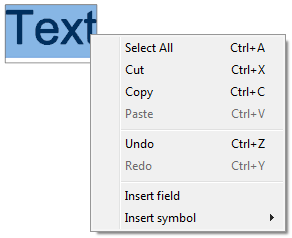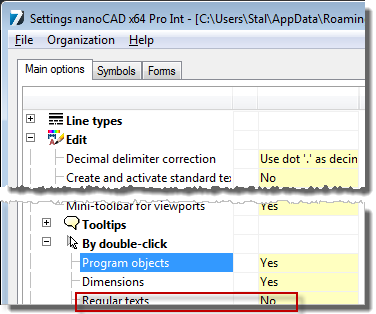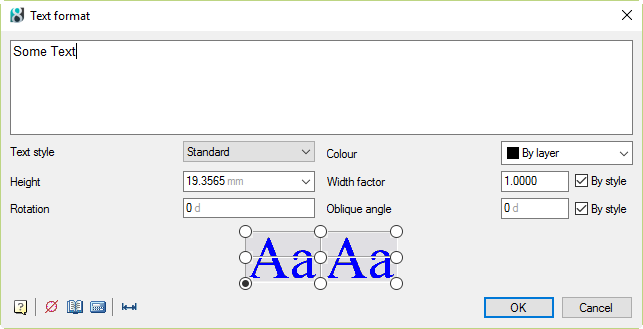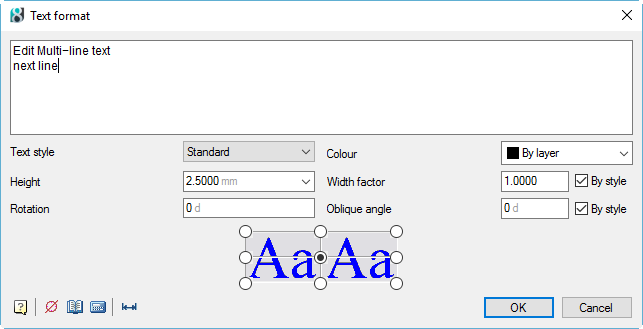Editing the content of the text objects








You can also start the Edit command from the context menu previously selected the text line in the document.
The command allows you to edit the content of a single-line text directly on the drawing. The content of the selected single-line text is selected and highlighted automatically to completely edit the text. If necessary, you can insert or delete single characters or fragments within the line. For more convenient editing, use the context menu:

Context menu options:
| Select all | The entire text line will be selected. |
|---|---|
| Cut | Cuts the selected text to the clipboard. |
| Copy | Copy the selected text to the clipboard. |
| Paste | Paste text from the clipboard. |
| Undo | Undo the last action. |
| Redo | Redo the previously undone action. |
| Insert field | Insert a field. |
| Insert symbol | Inserts a symbol. Available symbols:
|
You can also edit the single-line text in the drawing by double-clicking (if No is chosen for the Regular texts option of the Settings nanoCAD Int dialog box on the Main options tab of the By double-click section (the Tools menu – Design Settings)).

Press CTRL + ENTER or click on the drawing out of the single-line text to confirm changes and finish the editing.
To finish the editing without saving changes, press ESC.
NOTE: Press ENTER to split the single-line text into two lines, each of which is transformed into a separate text object after the command end.
You can edit not only text content, but also the options in the Text settings dialog box (if Yes is chosen for the Regular texts option of the Settings nanoCAD Int dialog box on the Main options tab of the By double-click section (the Tools menu – Advanced Settings)). The Text settings dialog box can be opened:
- by double-clicking on the text,
- by right button clicking with CTRL pressed on the text,
- by moving the cursor over the text and clicking the right button,
- by the edit and fedit commands.
The Text settings dialog box:

| Text field | Field for display and editing of the text line content. |
|---|---|
| Text style | Drop-down list to select the text style. |
| Color | Drop-down list to select the color of the text line. |
| Height | Drop-down list to select the height of the characters. Keyboard input is also possible. |
| Width factor | Sets the character spacing. Entering a value less than 1.0 condenses the text. Entering a value greater than 1.0 expands it. |
| Oblique | Sets the oblique angle of the text. |
 |
The fields display/specify the compatibility of the width factor and oblique of the edited text symbols by the value set in the text style. For text in which the width factor and/or oblique of the symbols correspond to the specified text style, the check boxes are selected in these fields  If the width factor and/or oblique of the symbols does not correspond to the specified text style, the check boxes are not selected:  The current values of the editable text are displayed in the input fields for the width factor and oblique. To set the width factor and oblique for the editable text to the values which correspond to those set in the text style, it is necessary to select the check boxes. Values are changed automatically:  |
 |
Text justifying tool. Select text origin point. See the Justify Text command for more information about text justifying. |
 Take from notes Take from notes |
Opens the Notepad. |
 Calculate Calculate |
Opens the Calculator. |
 Fit text Fit text |
Runs the Text Fit command. |
The Insert special symbol 

The buttons
 ,
,  ,
,  of this menu, in turn, also open
of this menu, in turn, also open
Menus of some mathematical and other symbols

Uppercase Greek letters menu

Lowercase Greek letters menu

NOTE: Special characters are displayed correctly only with correct fonts. When you are using a TrueType, question marks or blocks may be displayed instead of the special characters.
To insert symbols:
1. Place the cursor in the required position in the text line.
2. Click the Insert special symbol 
3. Select the required symbol.
4. When you click on the symbol, the additional menu will be closed and the symbol will be inserted automatically at the current position of the cursor in the text line.
Editing Multiline Text









When you run the command and select a multiline text for editing, the same dialog box of the text editor when creating multi-line text opens (for more information, see the «Multiline text» section).
The Text format dialog box when No is chosen for the Multi-texts option of the Settings nanoCAD Int dialog box on the Main options tab of the By double-click section (the Tools menu – Advanced Settings) can be opened:
- by double-clicking on the text.
You can edit a multi-line text in the Text settings dialog box (if Yes is chosen for the Multi-texts option of the Settings nanoCAD Int dialog box on the Main options tab of the By double-click section (the Tools menu – Design Settings)). The Text settings dialog box can be opened:
- by double-clicking on the text,
- by right button clicking with CTRL pressed on the text,
- by moving the cursor over the text and clicking the right button,
- by the edit and fedit commands.
The Text settings dialog box:

Options:
| Text | Field for display and editing of the text line content. |
|---|---|
| Color | Drop-down list to select the color of the text line. |
| Height | Drop-down list to select the height of the characters. Keyboard input is also possible. |
  Take from notes Take from notes |
Text justifying tool. Select text origin point. See the Justify Text command for more information about text justifying. |
 Take from notes Take from notes |
Opens the Notepad. |
 Calculate Calculate |
Opens the Calculator. |
 Fit text Fit text |
Runs the Text Fit command. |
 Insert special symbol Insert special symbol |
Opens an additional menu that allows you to select and insert the special symbols into the current text line (for more information, see the Editing single-line text section). |
Start the command and select the multiline text. The Text format dialog box opens. You can also activate the editing mode, by double clicking on the multiline text.
To edit the content and options of multiline text in the Text format dialog box:
1. Select the text fragment in the text box and replace it with new text or type additional text. When text is selected, the following options are available in the context menu: Select All, Cut, Copy, Paste, Undo, Redo, Insert symbol.
2. Change the options for the selected text by using the tools of the Text format dialog box.
3. To end multiline text editing, press CTRL+ENTER or click OK in the Text format dialog box. You can also click out of the text input area on the drawing to complete text the typing.
NOTE: Press ESC to cancel the text input and finish the command.




Post your comment on this topic.